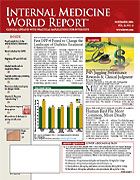Publication
Article
Internal Medicine World Report
Capsule Endoscopy Promising Tool to Visualize the Colon
Author(s):
From the American College of Gastroenterology
Las Vegas—Although in an early phase of investigation, colon capsule endoscopy (PillCam COLON) may one day prove a useful complement to optical colonoscopy as a screening tool in at-risk patients, said Blair Lewis, MD, of Mount Sinai School of Medicine, New York City, at the 71st Annual Scientific Meeting of the American College of Gastroenterology.
The capsule colonoscopy showed promise as a new technology for visualizing the colon in a serially blinded study presented at the meeting. Capsule endoscopy is already approved by the FDA for imaging of the esophagus and the small bowel.
Methods to increase adherence to colorectal cancer screening are needed, as only about 40% of those at risk of colorectal cancer undergo screening, said Dr Lewis.
“This capsule colonoscopy may complement traditional colonoscopy for contraindicated colonoscopy, incomplete colonoscopy, and in patients unwilling to undergo standard colonoscopy,” he said.
The capsule used for colon capsule endoscopy has 2 imagers that obtain 4 frames per second. “The capsule exits the body within 10 hours in 90% of people,” said Dr Lewis.
Colon capsule endoscopy was compared with virtual colonoscopy and standard optical colonoscopy in a serially blinded study of 51 volunteers aged >50 years. A total of 31 patients presented for screening, 16 because of a family history of colorectal cancer, 3 for blood in the stool, and 1 for a personal history of colon polyps.
All the volunteers initially underwent colon capsule endoscopy and within 3 weeks took a second preparation and underwent virtual and standard colonoscopy on the same day. The colonoscopist was blinded to the findings of the previous tests. At standard colonoscopy, the results of the previous 2 tests were serially unblinded.
Polyps of any size were found in 29 of the 51 patients (57%)—60 polyps were found by unblinded colonoscopy, 55 by colonoscopy, 94 by capsule colonoscopy, and 26 by virtual colonoscopy examination.
Some 17 adenomatous polyps were found in 15 patients; 16 were detected by standard colonoscopy (1 was missed and found on unblinded colonoscopy), 12 were detected by capsule colonoscopy, and 5 were detected by virtual colonoscopy. Sensitivity and specificity data are listed in the Table.
“Capsule colonoscopy appears to be more sensitive than virtual colonoscopy in detecting small colon polyps,” said Dr Lewis.
Patient surveys showed a preference for the capsule colonoscopy over the optical and virtual colonoscopy, he said.
Another study suggests that patients who have no colorectal neoplasia on an index colonoscopy can wait longer than 5 years to be rescreened, said Thomas Imperiale, MD, of Indiana University, Indianapolis.
Among 2436 patients who had no adenomas at baseline, 1256 returned for screening 5 years later. No cancers were found on the rescreening. Polyps larger than 1 cm were found in 16%; advanced adenomas were identified in 1.2% of the patients on rescreening.
Men were more likely than women to have any adenoma (20.1% vs 10.7%) or advanced adenomas (1.7% vs 0.55%).





